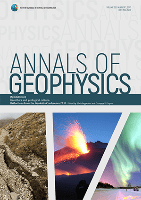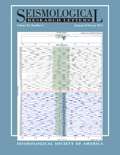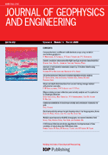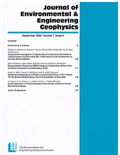
Applied Geophysics
Scope & Guideline
Uncovering Insights for a Sustainable Future
Introduction
Aims and Scopes
- Geophysical Modeling and Inversion Techniques:
The journal emphasizes advancements in modeling and inversion techniques across various geophysical methods, including seismic, electromagnetic, and gravity data. This includes the development of algorithms and methodologies for accurate subsurface imaging and characterization. - Natural Resource Exploration and Assessment:
Research published in the journal often pertains to the exploration and assessment of natural resources, including oil, gas, geothermal energy, and minerals. This focus extends to the evaluation of reservoir properties and the optimization of extraction techniques. - Seismology and Earthquake Studies:
A significant portion of the journal's content deals with the study of seismic events, including earthquake detection, characterization, and risk assessment. This includes both theoretical studies and practical applications in monitoring seismic activity. - Environmental and Engineering Geophysics:
The journal addresses geophysical applications related to environmental issues, such as landslide detection, groundwater assessment, and contamination studies. It also covers engineering applications, including tunnel monitoring and foundation assessments. - Machine Learning and Data Science in Geophysics:
There is a growing emphasis on the integration of machine learning and data science techniques within geophysical research. This includes automated data processing, pattern recognition, and predictive modeling using advanced computational methods.
Trending and Emerging
- Integration of Machine Learning Techniques:
The use of machine learning and artificial intelligence in geophysical studies is on the rise. This includes applications such as automated data interpretation, enhanced imaging techniques, and predictive modeling, which are becoming vital for advancing geophysical research. - Focus on Sustainable Resource Management:
Research addressing the sustainable management of natural resources, particularly in the context of energy transitions and environmental impacts, is increasingly prevalent. This includes studies on geothermal energy, CO2 storage, and the environmental impacts of resource extraction. - Advanced Monitoring and Detection Systems:
There is a growing emphasis on the development of sophisticated monitoring systems for geological hazards and environmental changes. This includes real-time monitoring of seismic activity, landslides, and subsurface fluid movements, reflecting an increasing concern for public safety and environmental protection. - Interdisciplinary Approaches to Geophysical Challenges:
The journal is increasingly publishing studies that adopt interdisciplinary approaches, combining geophysics with fields such as geology, hydrology, and environmental science. This trend reflects the complexity of modern geophysical challenges that require collaborative solutions.
Declining or Waning
- Traditional Geophysical Survey Methods:
There has been a noticeable decline in publications focusing solely on traditional geophysical survey techniques without the incorporation of advanced technologies or methodologies. As the field progresses, there is a shift towards integrating traditional methods with modern computational tools. - Basic Theoretical Studies:
Research that is purely theoretical in nature without practical application has become less common. The journal increasingly favors studies that include real-world applications or case studies that demonstrate the practical utility of theoretical advancements. - Single-Method Approaches:
There is a waning interest in studies that focus on single-method geophysical approaches. The trend is moving towards more interdisciplinary research that combines multiple geophysical techniques for enhanced subsurface characterization.
Similar Journals

IZVESTIYA-PHYSICS OF THE SOLID EARTH
Unveiling the Secrets of Our PlanetIZVESTIYA-PHYSICS OF THE SOLID EARTH, published by MAIK NAUKA/INTERPERIODICA/SPRINGER, serves as a pivotal platform in the field of Earth and Planetary Sciences as well as Environmental Science. With an ISSN of 1069-3513 and E-ISSN 1555-6506, the journal has been disseminating influential research since its inception in 1996, and continues to extend its contributions through 2024. Currently ranked in the Q3 category for both Earth and Planetary Sciences and Environmental Science, it showcases innovative studies that are crucial for understanding geological processes and their environmental implications. Located at 233 Spring St, New York, NY 10013-1578, the journal appeals to researchers, professionals, and students by providing insights and advancements that are at the forefront of these significant scientific disciplines. Although not open access, its rigorous peer-reviewed articles are essential reads for those aiming to deepen their knowledge and stay abreast of current trends and research in solid Earth physics.

ANNALS OF GEOPHYSICS
Innovating Solutions for Environmental ChallengesANNALS OF GEOPHYSICS is a prestigious open access journal dedicated to the advancement and dissemination of research in the field of geophysics. Published by the IST NAZIONALE DI GEOFISICA E VULCANOLOGIA in Italy, this journal has embraced open access since its inception in 1948, promoting wide accessibility to cutting-edge research. With an impressive Scopus ranking, placing it in the 52nd percentile within Earth and Planetary Sciences for the category of Geophysics, the journal serves as a vital platform for scholars, researchers, and practitioners seeking to explore the intricate phenomena of our planet. Covering a diverse range of topics in the geophysical community, the ANNALS OF GEOPHYSICS invites contributions that push the boundaries of our knowledge and understanding of geophysical processes, aiding in the development of innovative solutions to urgent environmental challenges. Published continuously from 2002 to 2024, the journal’s commitment to quality and rigor is reflected in its Q3 quartile ranking for 2023, making it a notable resource for the academic community.

Geofizicheskiy Zhurnal-Geophysical Journal
Illuminating Complex Geophysical ChallengesGeofizicheskiy Zhurnal-Geophysical Journal, published by the esteemed S I Subbotin Institute of Geophysics, National Academy of Sciences of Ukraine, stands as a vital resource for professionals and researchers in the field of geophysics. With an ISSN of 0203-3100 and an E-ISSN of 2524-1052, this journal is recognized for its rigorous peer-reviewed articles that delve into various aspects of geophysical research, including seismic studies, geodynamics, and Earth surface processes. Although currently not under an open access model, the journal maintains a commitment to disseminating high-quality research, thereby enriching the global geophysical community. The publication aims to foster collaboration and knowledge transfer among scientists and engineers while addressing complex geophysical challenges in a rapidly evolving landscape. By engaging with cutting-edge research, readers can expect to uncover insights that advance both theoretical understanding and practical applications in geophysical science.

SEISMOLOGICAL RESEARCH LETTERS
Empowering researchers to shape the future of geophysics.SEISMOLOGICAL RESEARCH LETTERS is a leading journal in the field of geophysics, published by the Seismological Society of America. With its ISSN 0895-0695 and E-ISSN 1938-2057, this prestigious publication serves as a vital platform for disseminating groundbreaking research and advancements in seismological science. The journal boasts an impressive Q1 categorization in the 2023 rankings and ranks 23rd out of 165 in Earth and Planetary Sciences, Geophysics, placing it within the 86th percentile among its peers. Spanning an illustrious history from its origination in 1984 to its ongoing contributions through 2024, it is dedicated to fostering a deeper understanding of seismic phenomena. Although it currently does not offer open access, researchers, professionals, and students can benefit from timely insights and comprehensive studies presented in its pages. Set within the heart of the United States, the journal stands as a cornerstone in geophysics, connecting a global community eager to advance their knowledge and impact in the field.

Geodynamics
Exploring the Forces Shaping Our PlanetGeodynamics is an emerging scholarly journal published by LVIV POLYTECHNIC NATIONAL UNIVERSITY, dedicated to advancing knowledge in the fields of Earth and Planetary Sciences, with a particular emphasis on Geophysics, Geology, and related specialties. Featuring both ISSN 1992-142X and E-ISSN 2519-2663, this journal aims to publish high-quality research that addresses critical challenges in geodynamic processes and their implications on our planet's systems. Despite its nascent status, having converged years from 2023 to 2024, Geodynamics is poised to attract attention in the academic community, especially as evidenced by its rankings in Scopus, which position it prominently within the discipline. The journal's commitment to open access ensures that cutting-edge research is readily available to the global scientific community, fostering collaboration and innovation. Researchers, professionals, and students will find Geodynamics an essential resource for the latest findings and discussions in geodynamics and related fields, making it an invaluable addition to the landscape of environmental science journals.

Journal of Geophysics and Engineering
Driving Innovation Through Geophysical Research and Engineering ApplicationsJournal of Geophysics and Engineering, published by Oxford University Press, stands as a pivotal platform for the dissemination of innovative research in the interdisciplinary fields of geology, geophysics, and engineering. Since its inception in 2004, this Open Access journal has focused on advancing the understanding of geophysical phenomena and their applications in engineering, receiving a commendable Q2 ranking in multiple categories for 2023, including Geology and Geophysics. With an impressive Scopus ranking reflecting its influence—such as a 143rd position in Earth and Planetary Sciences: Geology—this journal is essential for researchers, professionals, and students seeking to engage with cutting-edge advancements and policy discussions in these critical areas. The journal’s commitment to fostering knowledge and collaboration within the global scientific community positions it as a must-read for those dedicated to furthering geophysical and engineering sciences.

Interpretation-A Journal of Subsurface Characterization
Pioneering Research at the Intersection of Geology and GeophysicsInterpretation: A Journal of Subsurface Characterization is a premier academic journal dedicated to advancing the methodologies and technologies integral to the characterization of subsurface environments. Published by the Société de l'Exploration Geophysicists (SEG), this journal serves the fields of geology and geophysics, reflecting its critical role in the intersection of these domains. With an h-index that underscores its scholarly impact and its ranking in the Q2 category for both Geology and Geophysics, Interpretation is recognized for publishing high-quality, innovative research that offers valuable insights and solutions to contemporary challenges in subsurface exploration. Since its inception in 2013, the journal has quickly become essential reading for researchers, professionals, and students alike, providing open access to a wealth of knowledge fostering collaboration and advancement within the geoscience community. Featuring a comprehensive range of studies, methodologies, and reviews, Interpretation is integral for professionals striving to enhance their understanding of subsurface dynamics and impacting areas such as resource management, environmental conservation, and hazard assessment.

SURVEYS IN GEOPHYSICS
Unveiling the Secrets of Our Planet's Physical ProcessesSURVEYS IN GEOPHYSICS is a leading academic journal published by SPRINGER that has been at the forefront of advancing the field of geophysics and geochemistry since its inception in 1986. With an impressive impact factor and consistently ranked in the top quartile (Q1) of its categories—Geochemistry and Petrology, and Geophysics—this journal represents a vital resource for researchers and professionals alike. The journal is indexed in Scopus, where it ranks among the top ten in both Earth and Planetary Sciences sectors, reflecting its high citation rates and significant contributions to the field. Although not an open access journal, SURVEYS IN GEOPHYSICS provides invaluable insights into contemporary research trends and methodologies, fostering a deeper understanding of the physical processes that shape our planet. The journal welcomes original research articles, comprehensive reviews, and surveys that significantly contribute to our knowledge of geophysical phenomena and are dedicated to supporting the academic community through rigorous peer review and publication. Located in the Netherlands, SURVEYS IN GEOPHYSICS continues to establish itself as an essential platform for scholarly exchange and innovative ideas.

JOURNAL OF ENVIRONMENTAL AND ENGINEERING GEOPHYSICS
Pioneering Research in Environmental Engineering and GeophysicsJOURNAL OF ENVIRONMENTAL AND ENGINEERING GEOPHYSICS, published by the ENVIRONMENTAL ENGINEERING GEOPHYSICAL SOC, serves as an essential platform for the dissemination of cutting-edge research in the interconnected fields of environmental engineering, geophysics, and geotechnical engineering. This journal, with the ISSN 1083-1363 and E-ISSN 1943-2658, boasts a solid reputation, reflected in its Q3 rankings in several categories as of 2023. As it converged from 2001 to 2024, the journal has evolved to meet the increasing demand for innovative solutions to contemporary environmental challenges. Researchers are encouraged to submit original articles that contribute meaningfully to our understanding of the subsurface environment and its engineering implications. The journal is indexed in Scopus, with commendable rankings including 72nd out of 165 in Geophysics, highlighting its role in advancing knowledge and application in Earth and Planetary Sciences. Although not an open access journal, subscribers and institutions alike recognize the value of its rigorous peer-reviewed content, ensuring that professionals and scholars are equipped with the latest findings and methodologies in this dynamic field.

Acta Geodaetica et Geophysica
Bridging Geodesy and Geophysics for a Sustainable FutureActa Geodaetica et Geophysica is a prestigious journal published by Springer, focusing on the interdisciplinary domains of geodesy, geology, and geophysics. With an ISSN of 2213-5812 and E-ISSN of 2213-5820, this journal serves as a vital resource for researchers, professionals, and students interested in building and construction, as well as the broader aspects of Earth and planetary sciences. Operating since 2013 and poised to continue until 2024, Acta Geodaetica et Geophysica has consistently maintained its relevance within the academic community, evidenced by its Q3 quartile ranking in the fields of Building and Construction, Geology, and Geophysics for 2023. The journal's Scopus ranks highlight its competitive standing, ranking 118 out of 321 in Geology, and 66 out of 165 in Geophysics, reflecting its impactful contributions to the field. Although this journal does not offer open access, it remains an essential publication that enriches ongoing research and promotes knowledge dissemination in Hungary and beyond. Researchers and academics seeking to advance their studies will find valuable insights and rigorous analyses within its pages, making it a cornerstone of contemporary geoscience literature.